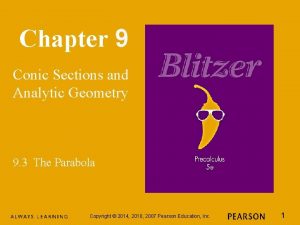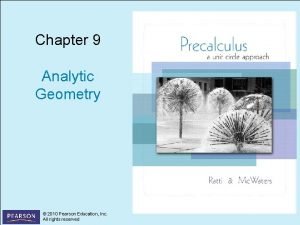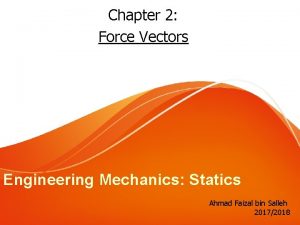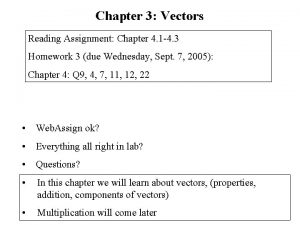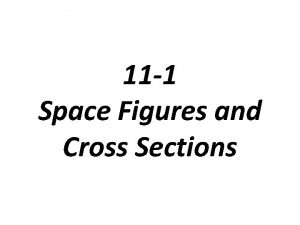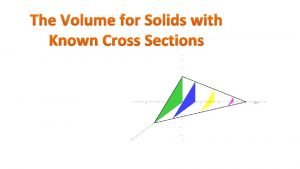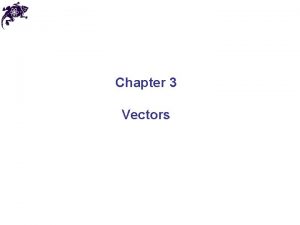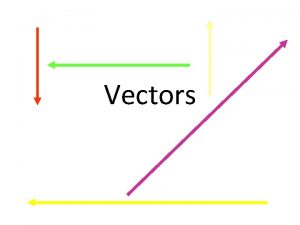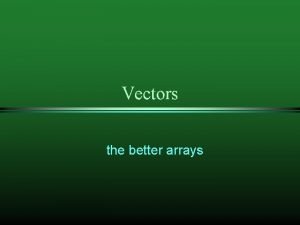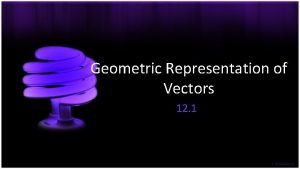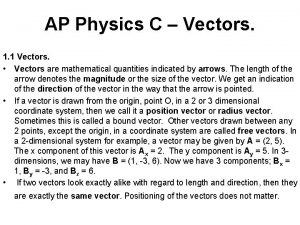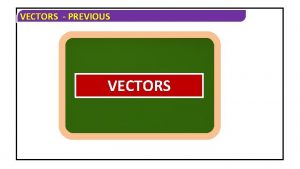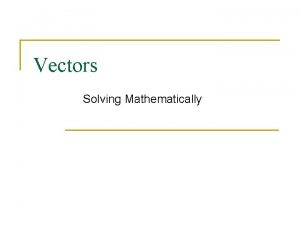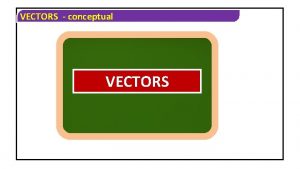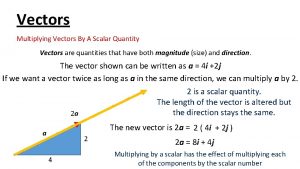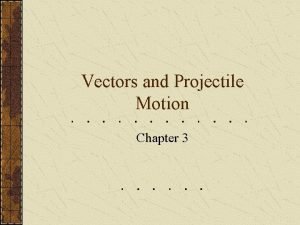Vectors Chapter 3 Sections 1 and 2 Vectors





















- Slides: 21

Vectors Chapter 3, Sections 1 and 2

Vectors and Scalars • Measured quantities can be of two types • Scalar quantities: only require magnitude (and proper unit) for description. Examples: distance, speed, mass, temperature, time • Vector quantities: require magnitude (with unit) and direction for complete description. Examples: displacement, velocity, acceleration, force, momentum

Vector Addition • When 2 or more vectors act on an object, the total effect is the vector sum • Special math operations must be used with vectors • Vector sum called the resultant • Sum can be found using graphic methods (drawing to scale) or mathematical methods

Adding Vectors Graphically • Choose a suitable scale for the drawing • Use a ruler to draw scaled magnitude and a protractor for the direction • Vectors can be moved in a diagram as long as their length and direction are not changed • Vectors can be added in any order without changing the result

Adding Vectors Graphically • Use head-to-tail method for series of sequential vectors where each successive vector begins where the preceding vector ended • Also works for two vectors acting simultaneously at the same point, although drawing doesn’t match the physical situation

Adding Vectors Graphically • Resultant is a vector drawn from point of origin to tip of last vector • Magnitude of resultant can be found by measuring and converting the measurement using the scale of the drawing • Direction is found by measuring angle with a protractor

Adding Vectors Graphically • Graphical method gives approximate values depending on drawing accuracy One dimensional graphical addition of vectors

Subtracting Vectors • To subtract a vector, add a negative vector, one having same magnitude but opposite direction a b b a +b a -b a a-b

Parallelogram Method • Vectors are drawn from a common origin • Complete parallelogram by drawing opposite sides parallel to vectors • Resultant is the diagonal of the parallelogram

Pros and Cons for Graphical Methods • For simultaneous vectors like forces, parallelogram method gives a better picture of actual situation • More difficult to draw accurately • Better for sketches, not for measured drawings • Head-to-tail method better for measuring

Parallelogram Method • a+b=r a r b

Adding Vectors Mathematically • Exact values for vector sums using trig functions (tan mostly) and Pythagorean theorem • Set up vectors on x-y coordinate system • If vectors act at right angles, Pythagorean theorem gives resultant magnitude • Direction can be found with tan-1 function

Resolving Vectors Into Components • A vector acting at an angle to the coordinate axes can be resolved into x and y components that would add together to equal the original vector • The x-component = original magnitude times the cos of the angle measured from the x-axis • The y-component = original magnitude times the sin of the angle measured from the x-axis

Vector Components vx= (50 m/s)(cos 60 o) vy= (50 m/s)(sin 60 o)

Adding Non-perpendicular Vectors • Resolve each vector into x and y components • Add the x-components together and add the y-components together • Use Pythagorean theorem and tan-1 function to find magnitude and direction of resultant

Adding Non-perpendicular Vectors y y x x

Adding Non-perpendicular Vectors Rx = 11. 3 + 12. 5 = 23. 8 Ry= 4. 1 + 21. 7 = 25. 8 @

Alternate Method for Adding Nonperpendicular Vectors • Consider a vector triangle with angles A, B, and C with opposites sides labeled a, b, and c A c B b C a

Alternate Method for Adding Nonperpendicular Vectors • Cosine law can be used to find magnitude of vector c if magnitudes and directions of a and b are known • Angle between a and b can be found using simple geometry • Sine law can be used to find direction of vector c

Cosine Law • Useful if two sides (a and b) and the angle between them (C) are known: • Similar to Pythagorean Theorem with a correction factor for lack of right angle

Sine Law • Useful when one angle and its opposite side are known along with one other side or angle
 Chapter 9 conic sections and analytic geometry
Chapter 9 conic sections and analytic geometry Chapter 7 conic sections and parametric equations
Chapter 7 conic sections and parametric equations Chapter 9 conic sections and analytic geometry
Chapter 9 conic sections and analytic geometry How many sections are in the chapter handbook for tx hosa?
How many sections are in the chapter handbook for tx hosa? A 100 lb weight hangs from two wires
A 100 lb weight hangs from two wires Chapter 12 vectors and the geometry of space solutions
Chapter 12 vectors and the geometry of space solutions Force vectors statics
Force vectors statics Chapter 3 vectors worksheets
Chapter 3 vectors worksheets This chapter shows how vectors can be added using
This chapter shows how vectors can be added using Cutaways and cross sections definition
Cutaways and cross sections definition Aristotle anatomy
Aristotle anatomy Body structures
Body structures 11-1 additional practice space figures and cross sections
11-1 additional practice space figures and cross sections Health and safety at work act 1974 section 3
Health and safety at work act 1974 section 3 Graduated commission definition
Graduated commission definition Pivoting section hair definition
Pivoting section hair definition Volumes with cross sections: squares and rectangles
Volumes with cross sections: squares and rectangles Body directional terms
Body directional terms Body planes and sections
Body planes and sections The multimodal text big ed mona
The multimodal text big ed mona How to find volume of a semi circle
How to find volume of a semi circle Think on these things
Think on these things
